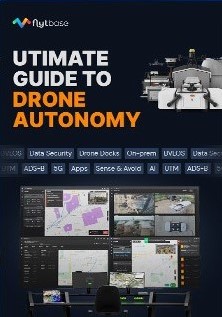San Jose, California (USA), May 14, 2024: FlytBase, the leading enterprise drone autonomy platform, announces the launch of Flinks (short for FlytBase Links) to enable users to connect the FlytBase platform with a wide range of third-party applications and devices. Flinks acts as a unifying layer, allowing organizations to create end-to-end automated workflows and conduct fully autonomous, safe, and efficient drone operations.
Solving the Fragmentation in the Drone Ecosystem
Enterprise drone operations often require the coordination of various systems. For instance, conducting drone flights on one platform and visualizing other aircraft in your operating airspace on another can make collision avoidance challenging, particularly during BVLOS operations. The lack of integration between these systems increases the risk of accidents.
Similarly, the process of capturing drone data using one application, then manually transferring the data from the drone's SD card to another application for post-processing and analysis, can be time-consuming and prone to errors.
Furthermore, enterprises often utilize a variety of internal applications, such as Computer-Aided Dispatch (CAD) systems, video management systems, or alarm systems, to monitor their operations and dispatch drones to specific geolocations for inspection purposes. The absence of seamless integration between these various systems forces enterprises to rely on manual processes, leading to inefficient operations and compromised safety.
“We are introducing Flinks to bridge this gap between the enterprise stack and drone operations. It allows users to effortlessly connect the FlytBase platform with critical business systems such as alarm systems, video management, data processing, and more. By eliminating the need for complex, time-consuming manual interventions, Flinks enables enterprises to seamlessly incorporate autonomous drones into their existing operations. Moreover, enterprises with unique needs can build their own integrations with just a few clicks, without the need for complex code," highlights Nitin Gupta, founder & CEO of FlytBase.
Flinks includes six different integration types:
- Alarms: To integrate various alarm systems for drone response to incidents like motion sensors, fire alarms, and dispatch systems.
- Data Processing: To integrate data processing applications that help generate high-res maps, surface and 3D models, and reports tailored to specific applications.
- Live Streaming: To connect drone & dock video feeds with Video Management Systems (VMS) and other video storage or analytics applications for site security operations and incident response.
- Mission & Logs: To export detailed drone missions and data to apps that help manage your resources, batteries, and flight logs.
- Detect & Avoid: To integrate third-party cooperative & uncooperative aircraft detection systems to ensure safety and compliance with airspace regulations.
- UTMs: To integrate uncrewed traffic management systems for real-time airspace awareness.
To explore how Flinks can help create custom integrated drone workflows or explore the library of ready-to-use Flinks, visit: https://flyt.link/flinks.
FlytBase is expanding its library of flinks and is inviting organizations developing software applications like Video Management Systems (VMS), drone data processing or analytics tools, or flight safety systems such as UTMs (Unmanned Traffic Management), DAA (Detect and Avoid), and parachute systems to seamlessly integrate with FlytBase through Flinks.
By partnering with FlytBase, organizations gain access to FlytBase's extensive global network of drone service providers, system integrators, and enterprise customers, thereby expanding their reach.
To join the Flink Partner Program, visit: https://flyt.link/flinks.
Get Your Free Drone Autonomy Guide Today!


Baisali Ghosh
As a Marcom Manager at FlytBase, Baisali oversees the content strategy, creation, and management! With over 7 years of experience in the drone industry and 3 years of it at FlytBase, she’s a self-proclaimed drone fanatic and is obsessed with all things geographical. In 2022, she has been recognized as the “Women to Watch in UAS” for AI/Autonomy category by Women and Drones.
When she’s not busy hosting FlytBase’s webinar series or organizing NestGen - a global drone autonomy focused event, you can find her exploring the Patagonian Desert, the Mid-Atlantic Ridge, or the Yellowstone Caldera on Google Earth.


.svg)




.png)

.svg)
.png)
-min%202.jpg)


.png)

.png)